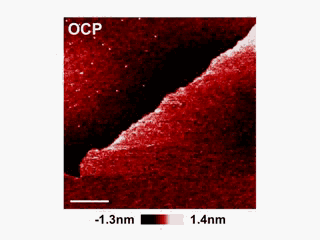Driving an Ultra-thin Solid Electrolyte Interphase Film: A Magic Power of the Electrolyte Additive
Direct tracking the interfacial processes at nanoscale in a working battery is highly important to reveal the reaction mechanism and further create the structure-reactivity correlations, which is of great guiding significance for interfacial engineering and prospective optimization of lithium-ion batteries (LIBs).
Recently, a joint research team led by Prof. WEN Rui and Prof. ZHENG Jian at Institute of Chemistry, Chinese Academy of Sciences (CAS) elucidated the structural evolution and reaction mechanism on ultra-flat monolayer molybdenum disulfide (MoS2) electrode upon charging/discharging. The work entitled “Ultra-thin Solid Electrolyte Interphase Evolution and Wrinkling Processes in Molybdenum Disulfide-based Lithium-ion Batteries” was published in Nature Communications.
Researchers intensively studied the interfacial processes on large-area ultra-flat MoS2 anode in the presence and absence of fluoroethylene carbonate (FEC) additives by in situ electrochemical atomic force microscopy (EC-AFM). Interestingly, the successive nucleation and growth of ultra-thin FEC-derived SEI film with thickness of 0.7 ± 0.1 nm was directly captured and quantitatively analyzed, deeply revealing the surface effect of the electrolyte additive. Furthermore, the appearance/retention of wrinkles, resulting from the phase transition of 2H MoS2 to 1T LixMoS2, were observed upon lithiation/delithiation, elucidating the intrinsic flexibility of MoS2 and failure mechanism of MoS2-based LIBs.
These results provide a comprehensive understanding of the quantitative live formation and interphasial morphology of ultra-thin SEIs derived from additives, as well as direct insights into the micro-mechanism of wrinkling process on the MoS2 anodes.
This work was supported by the Ministry of Science and Technology of China, the National Natural Science Foundation of China and the Chinese Academy of Sciences.

Video of in situ EC-AFM recording the initial process of formation of the ultra-thin FEC-derived SEI film upon charging. The scale bar is 600 nm. (Image by Prof. WEN Rui)
Contact:
Prof. WEN Rui
Institute of Chemistry, Chinese Academy of Sciences
Email: ruiwen@iccas.ac.cn





